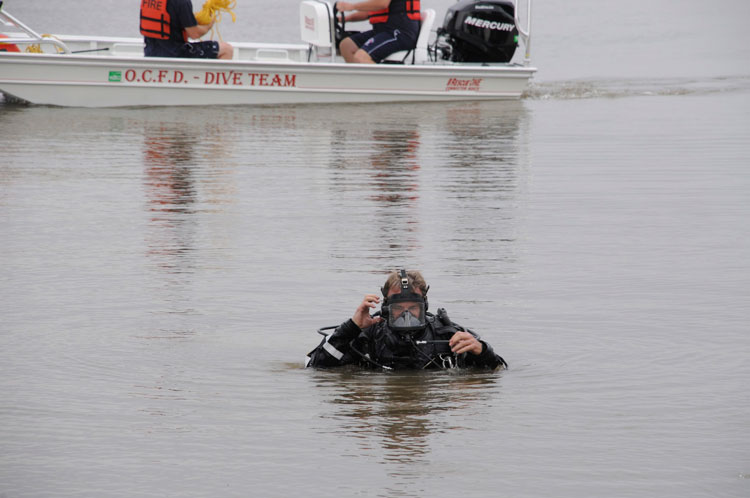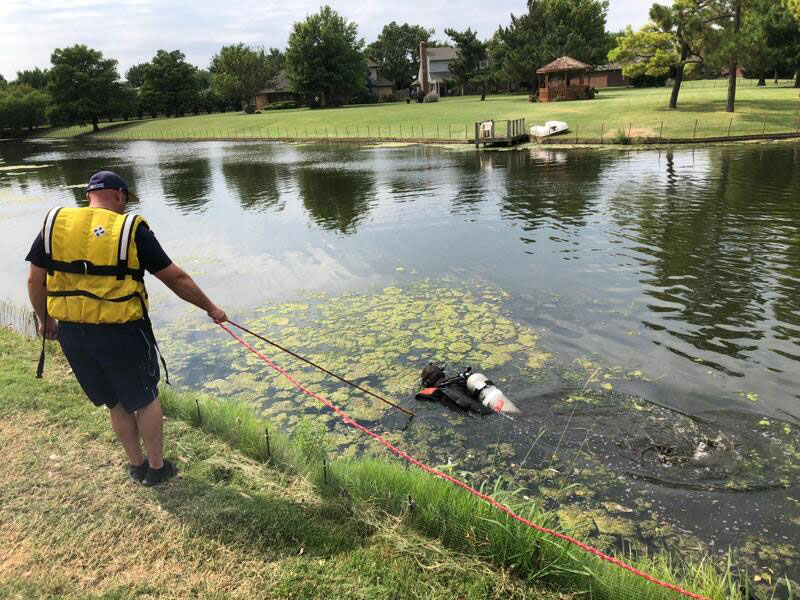

(1) A fire department diver undertakes dive operations. Photos by author except as noted.
Water-related incidents can cover a wide variety of emergency calls. Some fire departments may have a specialized rescue team that handles water responses, whereas other departments may have a regional or state team that can be called in to assist with these types of calls. Working at a special operations fire station that is tasked with responding to water-related emergencies, drowning, and evidence recoveries for almost a decade, our department has developed a few rules that work for us. This article will touch on just one part of water-related calls: what the first-arriving company can do when members arrive on a scene of a missing person in the water. This will also cover information that can be gathered and passed on to a water recovery team that is responding to your scene.
Here is a very real scenario. You are on duty and get a call to a large pond with reports of a swimmer in trouble. Upon arrival you are met by a frantic and screaming witness who directs you to an area by the water where two other people are staring across the water with tears on their face. As you look across the water, you see that the water is still—no bubbles, no waves, and no sign of any victim. What do you do now? What is your department’s policy? The witnesses quickly tell you that there was a child swimming across the pond and all of a sudden he started struggling, went under water, and has not yet surfaced. Now you know you may have a drowning. Who do you call for a body recovery? Does your department have a dive team? Will a regional or statewide team be deployed to your location? What information and actions can you do right now that will help to mitigate this incident?
RELATED
Water Rescue: Are You Ready Downstream?
Conducting a Common Hallway Rope-Assisted Search
Training Options for Your Dive Team
SCUBA Dive Rescue Operations: A Familiarization Course
As with all calls, there is not a “set in stone” way to handle every drowning. But we want to look at a few tips that you may be able to use on some of these type calls. First, make contact with the witnesses and separate them from other people. If possible, separate them from each other as well. It is crucial that you interview and gather information from these people quickly. This is especially true in situations where the recovery team is going to be delayed in getting to your location for any significant amount of time. Remember that the witnesses did not start their day planning on seeing such a traumatic scene such as someone drowning in front of them. They want to be helpful to us and they do not want to feel that they are wrong or giving incorrect information. The longer the witnesses talk to each other and compare stories and replay the scene in their minds, the greater the tendency to change the facts of the story to fit with the group. If at all possible, secure and separate them as soon as you can. The information that we collect now, while it is fresh and hopefully the most accurate, can have a large impact on the incident.

(2) Dive team members on a boat.
When talking to the witnesses, remember to let them tell us the story. Crucially, do not ask leading questions that may steer the witness accounts in the wrong direction. Another successful interview strategy is to place the witness in the same place they were standing when they witnessed the drowning. Try to have the witness visualize and think through the event. What seems like incidental information to them or us might be valuable to the recovery team.
Things you must try to find out:
- What happened?
- What led up to that event?
- Where was the victim last seen?
- How long since the victim was last seen?
Importantly, members must attempt to triangulate the location of the victim using stationary landmarks, which can be a challenging endeavor. If you can get the witness back in the place they were standing, try to use stationary objects in the background to establish boundaries or a reference point of last known location for the victim. The first on-scene crew also needs to draw out the scene and not leave the location up to their memory. If you have multiple witnesses from different angles and can get a triangulated position from each of them, you can greatly increase the efficiency of your search area.
Another tactic that has been very effective in our area is to recreate the scene using a firefighter in place of the victim. This tactic comes with some stipulations:
- Static (non-moving) water
- Non-contaminated water
- The water must be safe for firefighter entry
- The firefighter must be trained
- The firefighter must be equipped with life jacket
If all conditions are met, have the firefighter swim out to the location that the witness states they last saw the victim. While that firefighter is floating in the water, ask the witness to remember the event and ask them if the firefighter looks closer or farther away than the victim was. What we have found is that usually the firefighter gets to the location that the witness is reporting and they realize the victim was further away then they first thought. Then we can have the firefighter move to the new location, which is often much closer to the location to where the actual victim was found. Once we locate the area, we have the in-water firefighter drop a buoy to mark the spot. If you do not have a commercially sold buoy you can use a milk jug stuffed with rope and tied to a weight to make a buoy.

(3) Fire department divers operate in a pond. Photo by Brad Tobin.

(4) A diver navigates algae atop the pond while member on shore bearing a rope looks on. Photo by Brad Tobin.
Once you have gathered all this information, use it to establish a reasonable search area. While you are gathering this information and interviewing the witnesses, there are actions that the other members on scene can be doing. It is widely recommended that everyone within 10 feet of the water wear a life jacket, regardless of swimming ability. They can isolate the area and keep bystanders away from the water. Search for signs around the edge of the water that the victim was there and use the information in conjunction with the witness statements to help triangulate the victim’s position. The first-arriving company can begin to do a thorough search of the bank, placing special interest in the areas downstream or downwind of the last point scene for any signs of the victim.
Missing persons at water-related calls can be a difficult situation for crews to mitigate. Water recovery calls can sometimes take several hours or even days to complete. Crews should remember that incidents that start well usually end well. The more information you can gather from witnesses, the better educated you will be in establishing a search area. The better the search area, the less exposure the divers have to the conditions, the sooner fire companies can return to service, and the quicker the family can have peace of mind that their loved one has been found.
JOSH PEARCY has worked in fire/EMS for more than 16 years. He is a firefighter/paramedic for the Oklahoma City (OK) Fire Department, where he has served since 2007. For the past five years, he has been stationed at Station 8, the special rescue station for the Oklahoma City metro area. He has been a fire/EMS instructor for the past 12 years. He is a member of OK-TF1 and is certified as a firefighter II, a paramedic, a hazmat technician, a confined space technician, a structural collapse technician, a rope rescue technician, a trench rescue technician, a heavy extrication specialist, a swift water technician, an underwater dive recovery specialist, a dive instructor train-the-trainer, a fire department instructor, and a state EMS instructor. He has also presented at FDIC International.

